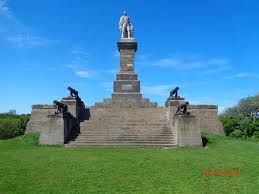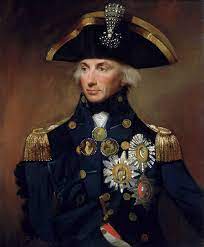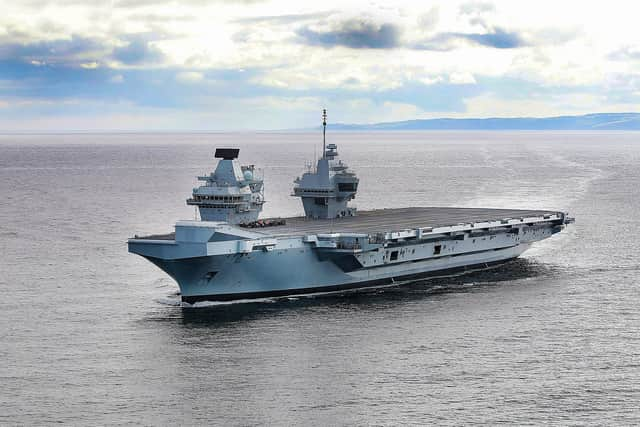Sarah Blackett, the daughter of John Erasmus Blackett, a prominent citizen of Newcastle, who was Mayor four times, married Cuthbert Collingwood at Newcastle on 16 June 1791. Cuthbert later became Admiral Lord Collingwood, and served as second-in-command to his old friend, Lord Nelson, at the Battle of Trafalgar in 1805. Collingwood’s ship, the Royal Sovereign, was faster than the Victory and was first to engage the enemy fleet, causing Nelson to comment “see how that noble fellow Collingwood carries his ship into action!” At about the same time Collingwood remarked “What would Nelson give to be here?” After Nelson’s death Collingwood took over command for the remainder of the battle.

In later life he was appointed commander of the Mediterranean fleet. When his health began to fail he made repeated requests to be allowed to return home. His pleas were finally answered, but he died of cancer on board HMS Ville de Paris having just set sail from Port Mahon en route for Britain, without seeing Sarah and their two daughters again. In 1838 a meeting was held in Newcastle proposing that funds should be raised for a monument to Collingwood. Two of the speakers were Sir Edward Blackett and Christopher Blackett MP. The Collingwood Monument now stands at the mouth of the River Tyne, looking out to sea.

Horatio Nelson, whose mother was a great-niece of Sir Robert Walpole (see Blackett family connections to Prime Ministers of the United Kingdom), was born in Burnham Thorpe, Norfolk in 1758. Probably around the time of his mother’s death in 1767 his father engaged a nurse to look after his younger children. The nurse was a young Mary Blackett (1760-1852) of Burnham Thorpe, the daughter of Peter Blackett. Although Mary would have spent more time with Nelson’s younger siblings, she would no doubt also have helped to look after him while he was home from school up to the time when he went to sea at the age of 12. Nelson and Collingwood had been friends for many years when Collingwood married Sarah Blackett, and it would, perhaps, have been surprising if the mention of her surname, an unusual one to Norfolk ears, did not prompt Nelson to remark on the coincidence, and possibly even speculate if there was a distant family connection with his family’s former nurse. In 1783 Mary Blackett married John High, the landlord of the “Old Ship Inn” at Brancaster, a few miles to the west of Burnham Thorpe. The marriage ceremony was carried out at St. Mary’s, Burnham Thorpe, by Horatio Nelson’s elder brother William. [i]
There is a further connection between Admiral Lord Nelson and the Blacketts. During the Battle of Copenhagen in 1801 Nelson, who was second-in-command of the British fleet, was ordered to disengage his squadron. Famously, he raised his telescope to his blind eye and ignored the order, (thus giving rise to the expression to “turn a blind eye” to something), and pressed on with the action, forcing the Danish forces to capitulate. The order had been given by Admiral Sir Hyde Parker, the father-in-law of Caroline Eden, the 3xgreat-granddaughter of Elizabeth Blackett.
Almost 200 years after Trafalgar, Commodore Jeff Blackett, (see also Sporting Blacketts ), then Commander of HMS Collingwood, the Royal Navy’s Weapons Electrical Training Establishment in Fareham, Hampshire, was asked to name newly built cabin accommodation. He decided to call it the “Sarah Blackett Suite” after Lord Collingwood’s wife, thus inviting the charge that he had named it after his own wife, Sally (a derivitive of Sarah)!
Several Blacketts served in the Royal Navy. In 1837 Midshipman John Charles Blackett, father of Admiral Henry Blackett, purchased at Pitcairn Island the medical book of H.M.S. Bounty from a descendant of Fletcher Christian. (See also Mutiny on the Bounty.) The book is now held by the National Maritime Museum. In 1841, four years after his visit to Pitcairn Island, John Charles Blackett arrived in Auckland Harbour, New Zealand in rather more style, in his own 80 ton yacht, Albatross, and entertained the Governor on board. Blackett’s Building in the centre of Auckland (see Blacket(t)s down under) is named after him.
Blackett Strait in the Solomon Islands, the scene of the sinking in 1943 of PT109, commanded by a young John F. Kennedy, later 35th President of the United States, is almost certainly named after Frederick Arthur Blackett, the youngest son of Sir Edward Blackett (VIth Bt.) In 1968, when a proposal for the renaming of the Strait after the late President Kennedy was briefly considered, enquiries established that although the derivation of the name was no longer known, Blackett Strait first appeared on Admiralty Charts between 1871 and 1881. Older local residents informed the British High Commissioner that the Strait was believed to be named after a Lieutenant on a Royal Navy survey ship.[ii]
After consulting the Navy Lists for the period, the only possible candidate we have come across is Lt. Frederick Arthur Blackett, who served on HMS Thalia, as part of the China Station (which included the Solomon Islands) from 7 Feb 1873 to 23 Jan 1874. He later was lost at sea on HMS Atalanta, which disappeared after departing Bermuda on 31 Jan 1880.
In “My Name is Blacket” Nick Vine Hall recounts how he learned of a family story about “Ma coosin Jarmie Cook” the famous explorer. Details of the link between Captain Cook and the Blackets can be found on John Barker’s excellent website, ClanBarker.
In 2022 NavyX, the research and development division of the Royal Navy, took delivery of the 270 tonne experimental vessel XV Patrick Blackett, named after Lord Blackett (see A Nobel Prize for a Blackett).
In 2024 Captain Will Blackett assumed command of one of the Royal Navy's two aircraft carriers, HMS Prince of Wales.

[i] For more details please see the article on Nelson’s family life at The Nelson Society website. We are indebted to Peter Neale for informing us of this connection.
[ii] Source: The National Archives.
